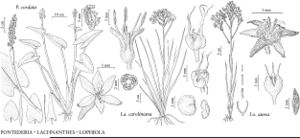Difference between revisions of "Lachnanthes caroliniana"
J. Bot. 70: 329. 1932.
FNA>Volume Importer |
FNA>Volume Importer |
(No difference)
| |
Revision as of 19:30, 24 September 2019
Stems 3–10.5 dm, distally whitish villous-tomentose when young, becoming tawny-hoary. Leaves: basal leaves 15–45 × 0.5–2.1 cm proximally, shorter distally; cauline leaves shorter than basal, decreasing in size distally, becoming bracts in inflorescence. Inflorescences initially rounded, becoming open and corymbose after anthesis, each branch resembling a helicoid cyme. Flowers: tepals erect-spreading at anthesis, pale yellow, 7–9 × 1–1.5 mm, densely pubescent abaxially, persisting and incurving to form beak around fruit; stamens spreading at anthesis; filaments 8–10 mm; anthers yellow; style persistent, slightly exceeding anthers, 10–13 mm. Capsules globose or oblate, 3–5 mm diam. Seeds reddish brown, 2.5–3 mm diam., faintly wrinkled. 2n = 48.
Phenology: Flowering mid–late summer.
Habitat: Wet, acid, often sandy soil of bogs, swamps, ditches, low areas in savannas and pinelands, margins of hammocks and pocosins
Elevation: 0–600 m
Distribution
N.S., Ala., Conn., Del., Fla., Ga., La., Md., Mass., Miss., N.J., N.Y., N.C., R.I., S.C., Tenn., Va., West Indies (Cuba).
Discussion
Lachnanthes caroliniana is sometimes a serious weed in commercial cranberry bogs.
Selected References
None.
